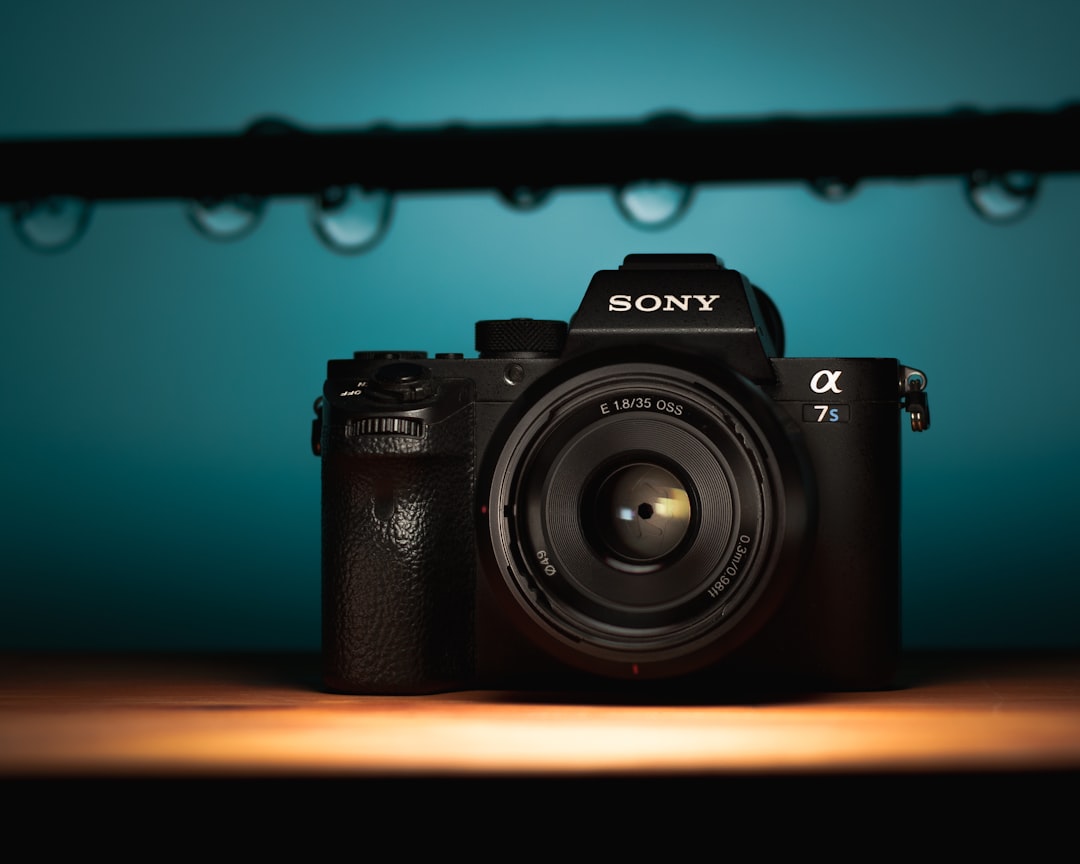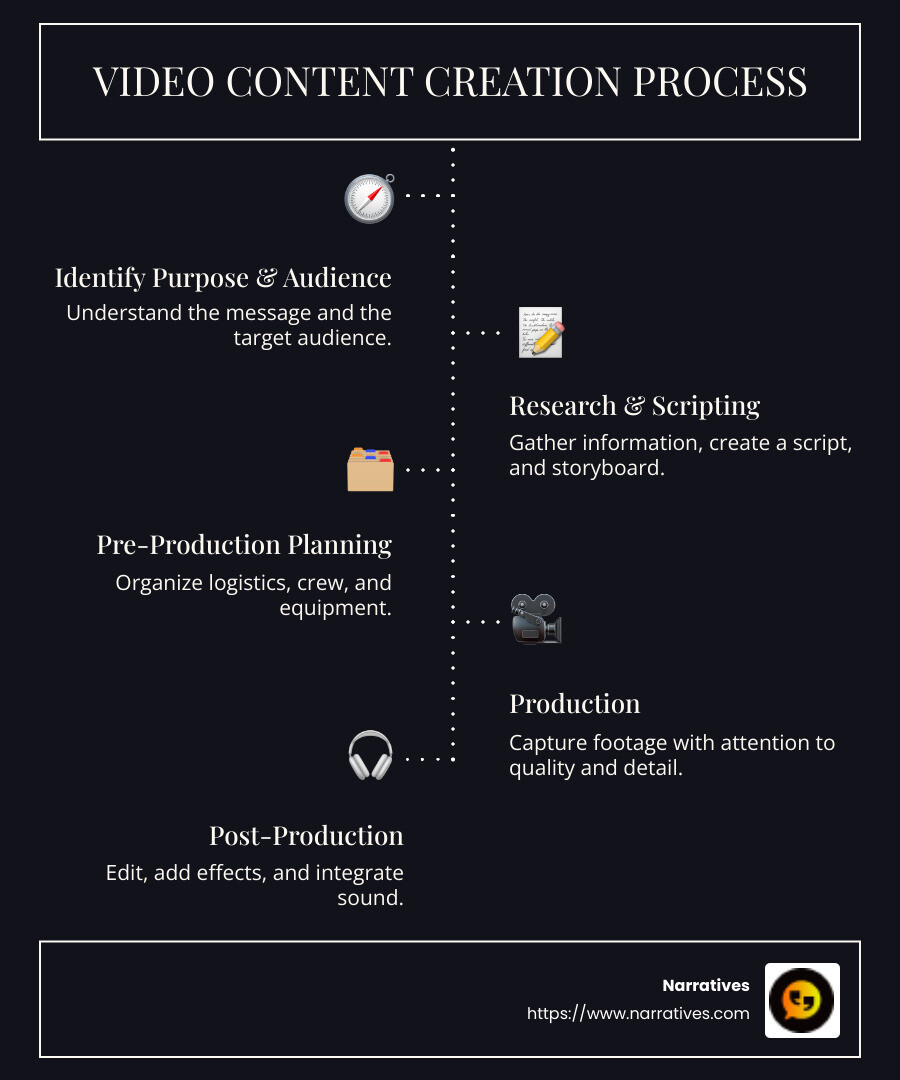Crafting Compelling Videos: Your Guide to the Creation Process

Video content creation process is a dynamic and powerful way to engage and captivate a digital audience. For those venturing into this process, understand the key steps involved:
- Identify your purpose and audience: Know the message you want to convey and to whom.
- Research and scripting: Gather information, create a script, and build a storyboard.
- Pre-production planning: Organize logistics, crew, and equipment.
- Production: Capture footage with attention to quality and detail.
- Post-production: Edit, add special effects, and integrate sound.
- Marketing & distribution: Share your final product widely across platforms.
In today’s digital world, videos outshine other content by effectively telling stories that resonate emotionally and intellectually. As the old adage goes, "A picture is worth a thousand words," but a well-crafted video can inspire change, evoke emotion, and drive action like no other medium. This is especially true for non-profits and socially driven organizations that thrive on storytelling to amplify their impact.
When crafting a story, it's crucial to blend authenticity with creativity. For organizations centered around social advocacy, diversity, equity, and inclusion, each story must be crafted with care. Authenticity not only builds trust but also strengthens your brand’s mission.
In the following guide, we'll dig deeper into the key stages of the video content creation process, equipping you with the knowledge and tools necessary to bring your narrative to life, engage your audience, and make meaningful connections.

Understanding the Video Content Creation Process
Creating compelling video content involves a multi-stage process that transforms an idea into an engaging visual story. Let's break down each stage:
Pre-Production Essentials
Audience Definition and Planning
Before the camera rolls, it's crucial to define your audience. Ask yourself: Who are they? What do they care about? Tailoring your video to a specific audience ensures your message resonates and engages effectively.
Scriptwriting and Storyboarding
Scriptwriting is where your video’s narrative takes shape. A well-crafted script provides a clear direction and helps maintain focus on the core message. Storyboarding follows, allowing you to visualize each scene. This step is vital for organizing the sequence of shots and ensuring a smooth production phase.
"The most important part of the video production workflow is actually what happens before the camera starts rolling."
Production Techniques
Filming
With the groundwork laid, it's time to capture your footage. Consistent filming techniques ensure high-quality visuals. Whether using a professional camera or a smartphone, focus on stability and clarity.
Lighting and Audio Capture
Lighting can make or break your video’s quality. Proper lighting improves the mood and visibility of your content. Meanwhile, clear audio is essential. Invest in quality microphones to capture crisp sound, as poor audio can quickly turn viewers away.
Post-Production Strategies
Editing
Editing is where the magic happens. This stage involves trimming footage, arranging scenes, and ensuring the narrative flows smoothly. It’s about refining your content to deliver a polished final product.
Special Effects and Sound Integration
Add special effects to improve storytelling, but use them sparingly to avoid overshadowing your message. Integrating sound, including background music and sound effects, adds depth and emotion to your video, making it more immersive.
By following these steps in the video content creation process, you can produce videos that not only inform but also inspire and engage your audience. Each stage, from planning to post-production, plays a critical role in creating a cohesive and impactful video narrative.
Types of Video Content for Non-Profits
Creating video content is a powerful way for non-profits to connect with their audience and convey their mission. Let's explore three effective types of video content: tutorial videos, educational videos, and user-generated content.
Tutorial Videos
Tutorial videos are step-by-step guides that teach viewers how to accomplish a task or use a product. For non-profits, these videos can demonstrate how to participate in a campaign, use a service, or even volunteer effectively. By providing clear and concise instructions, tutorial videos can empower viewers to take action and engage more deeply with your cause.
Example: Imagine a non-profit focused on environmental sustainability creating a tutorial video on how to start a community garden. This not only educates viewers on gardening but also promotes community involvement.
Educational Videos
Educational videos are designed to inform and enlighten your audience about specific topics related to your mission. These videos can break down complex issues into simple concepts, making them accessible to a wider audience. They can cover topics like social justice, health, or cultural awareness, aligning with your non-profit's goals.
Example: A non-profit advocating for social justice might produce an educational video explaining the impact of systemic inequality. This video could use engaging visuals and expert interviews to clarify the topic and inspire action.
User-Generated Content (UGC)
User-generated content is a powerful way to involve your audience directly. Encouraging your supporters to share their own stories, testimonials, or experiences related to your mission can create a sense of community and authenticity. UGC not only builds trust but also amplifies your message through the voices of those you support.
Example: A non-profit focused on aiding vulnerable populations might ask beneficiaries to share short video clips of how the organization has impacted their lives. These authentic stories can resonate deeply with viewers and potential donors.
Incorporating these types of video content into your strategy can lift your non-profit's message and foster a stronger connection with your audience. By leveraging the video content creation process, non-profits can craft compelling stories that drive awareness and inspire change.
Tools and Equipment for High-Quality Video Production
When it comes to creating high-quality video content, having the right tools and equipment is crucial. Let's explore some essential components: video cameras, stabilizers, and microphones.
Video Cameras
Choosing the right video camera is the first step in your video content creation process. A good camera can make all the difference in the quality of your footage. According to TechRadar, some of the top video cameras include the Panasonic Lumix GH6 and Sony A7S III. These cameras offer excellent image quality and are favored by many videographers for their reliability and performance.
Tip: If you're on a budget, modern smartphones can also capture high-definition 4K videos. While they might not match the capabilities of professional cameras, they are a great starting point for beginners or those looking to create content for social media.
Stabilizers
Nothing ruins a video faster than shaky footage. Stabilizers, such as gimbals or Steadicams, help keep your camera steady, ensuring smooth and cinematic shots. They use advanced technology to counteract movements, allowing you to focus on capturing your story.
Alternative: If a stabilizer is out of reach, a simple tripod can provide a stable base for your camera. It's a versatile tool that can be used in various shooting scenarios, making it a staple in any videographer's toolkit.
Microphones
Audio quality is just as important as video quality. Poor sound can distract viewers and diminish the impact of your content. Investing in a high-quality microphone is essential. Wired recommends options like the Rode SmartLav+ and Joby Wavo Plus for clear and crisp audio.
Consideration: The type of microphone you choose should match the nature of your video. For instance, lavalier mics are ideal for interviews, while shotgun mics are perfect for capturing dynamic sound on the go.
By equipping yourself with the right tools, you can significantly improve the quality of your video content. Whether you're using a top-tier camera or a smartphone, the key is to ensure that your visuals and audio are clear and engaging. With the right equipment, you're well on your way to creating compelling videos that captivate your audience.
Tips for Effective Video Content Creation
Creating standout video content requires more than just hitting the record button. Let's explore some essential tips to lift your video content creation process.
Pre-Production Planning
Before you start filming, thorough planning is crucial. This phase sets the foundation for your video. Begin by defining your audience. Knowing who you're speaking to helps tailor your message effectively.
Next, scriptwriting and storyboarding are vital. A well-written script guides your narrative, ensuring clarity and engagement. Storyboarding helps visualize scenes, making the filming process smoother.
Remember: The more you prepare, the fewer surprises you'll encounter during production.
Quality Equipment
Investing in quality equipment can significantly impact the final product. While smartphones offer convenience, professional cameras provide superior image quality and control. As mentioned earlier, cameras like the Panasonic Lumix GH6 are excellent choices for serious creators.
Don't forget about audio! A high-quality microphone ensures your message is heard clearly. Whether it's a lavalier mic for interviews or a shotgun mic for dynamic scenes, choose based on your needs.
Tip: Lighting is also crucial. Proper lighting can transform the look of your video, so consider investing in good lighting equipment or utilizing natural light effectively.
Video Composition
Composition is about how you frame your shots. Good composition makes your video visually appealing and guides the viewer's eye to what's important. Pay attention to lighting, framing, and the positioning of subjects within the frame.
Here are a few key aspects to consider:
- Lighting: Proper lighting improves mood and clarity. Experiment with different setups to find what works best for your scene.
- Framing: Position subjects thoughtfully within the shot. Use techniques like the rule of thirds to create balance.
- Composition: Arrange elements to form a cohesive and engaging image. This includes the relationship between objects and the overall flow of the scene.
By focusing on these areas, you ensure your video not only looks professional but also keeps viewers engaged from start to finish.
With these tips in mind, you're well-equipped to create compelling videos that resonate with your audience. Whether you're crafting educational content or promoting a cause, attention to detail in the planning and execution stages can make all the difference.
Frequently Asked Questions about Video Content Creation Process
Navigating the video content creation process can feel overwhelming. Let's address some common questions to help you understand the essentials.
What are the key stages of video production?
Video production is a multi-stage journey. It begins with Planning & Development, where you define your goal and audience. This stage sets the vision for your video.
Next is Pre-Production, which involves scriptwriting, storyboarding, and location scouting. This is where your ideas start taking shape on paper.
Production is the actual filming. Here, you capture the visuals and audio, ensuring you stick to the plan while being adaptable to changes.
In Post-Production, editing, color correction, and sound design come into play. This stage polishes your footage, turning it into a cohesive and engaging video.
Finally, Marketing & Distribution ensure your video reaches the right audience. Use data to tweak and refine your strategy, focusing on what works best.
How can non-profits leverage video content effectively?
Non-profits can harness the power of video to amplify their mission. Here’s how:
Storytelling: Share compelling stories that highlight your impact. Emotional narratives can connect deeply with viewers, encouraging support and donations.
Educational Videos: Create content that informs and educates. This can include tutorials or explainer videos about your cause, helping to engage and enlighten your audience.
User-Generated Content: Encourage supporters to share their stories. Authentic, real-life experiences can build trust and foster community involvement.
By using these strategies, non-profits can improve their visibility and inspire action.
What equipment is essential for video content creation?
The right equipment can lift your video quality significantly. Here’s a quick rundown:
Cameras: While smartphones are handy, invest in a good camera for higher quality. Consider options like the Panasonic Lumix GH6 for professional results.
Microphones: Clear audio is crucial. Choose microphones based on your needs—lavaliers for interviews or shotgun mics for dynamic scenes.
Lighting: Good lighting can transform your video. Invest in lighting kits or use natural light to your advantage.
These tools form the backbone of effective video production, ensuring your message is both seen and heard clearly.
With these FAQs addressed, you're better equipped to steer the video production landscape. Whether you're a non-profit or a business, understanding these elements can help you create impactful video content.
Conclusion
At Narratives, we believe in the transformative power of video to drive social impact and foster community-driven storytelling. Our mission is to lift underrepresented voices, helping non-profits and purpose-driven organizations share their stories in ways that inspire action and build trust.
Video content creation is not just about producing a video; it's about crafting a narrative that resonates with your audience. This process involves understanding your audience, developing a compelling script, and executing it with precision. Each stage, from pre-production to post-production, plays a crucial role in ensuring your message is clear and impactful.
In the field of social impact, videos have the unique ability to convey emotions and connect with viewers on a personal level. By showcasing real stories and genuine experiences, non-profits can highlight their missions and the communities they serve. This not only increases visibility but also encourages viewer engagement and support.
Community-driven storytelling is at the heart of what we do. By collaborating with non-profits, we aim to create content that not only informs but also empowers. Our focus is on authenticity and empathy, ensuring that every video we produce reflects the true essence of the stories being told.
In conclusion, crafting compelling videos is a journey that requires careful planning and execution. By leveraging the power of storytelling, non-profits can amplify their message, reach a wider audience, and ultimately, make a greater impact.
For more insights into how we can help you harness the power of video for your organization, learn more about our services. Let's work together to tell stories that matter and inspire change.



